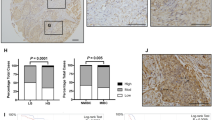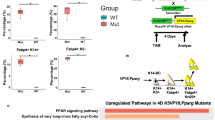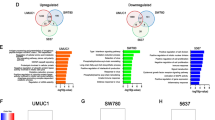Abstract
The differential expression of the desired gene product in the target tissue is central for gene therapy. One approach is to use a tissue-specific promoter to drive therapeutic gene expression. UroplakinII (UPII) is a urothelium-specific membrane protein. To investigate the feasibility of targeting gene therapy for bladder cancer, a DNA fragment of 2542-bp upstream of the UPII gene was amplified by PCR and linked to a promoterless firefly luciferase reporter gene. The transient transfection showed that the DNA fragment resulted in preferential expression in bladder carcinoma cells, with negligible expression in nonurothelium cells. Furthermore, the DNA segment located between −2545 and −1608 decided the tissue-specificity of the UPII promoter, the segment located between −328 and −4 being the core promoter of UPII. We generated two recombinant adenoviruses under the control of the UPII promoter: Ad-hUPII-GFP, carrying green fluorescence protein (GFP), and Ad-hUPII-TNF, carrying the tumor necrosis factor alpha (TNFα). ELISA revealed that the secretion of TNFα by Ad-hUPII-TNF-infected bladder cancer cells was significantly higher than Ad-hUPII-TNF-infected nonurothelium cells. The conditioned medium from Ad-hUPII-TNF-infected bladder cancer cells apparently inhibited the proliferation of L929 cells, a TNFα-sensitive cell line, comparing to Ad-hUPII-TNF-infected nonurothelium cells. Intravesical inoculation with Ad-hUPII-TNF inhibited tumor growth in the orthotopic human bladder cancer model. The sustained high level of TNFα in urine was identified with ELISA. Taken together, these data suggest that most of the cis elements that confer the bladder-specificity and differentiation-dependent expression of the human UPII gene reside in the 2542-bp sequence, and TNFα driven by the human UPII (hUPII) promoter is effective in the specific inhibition of bladder cancer growth both in vivo and in vitro. These results may yield a new therapeutic approach for bladder cancer and provide information on the molecular regulation of urothelial growth, differentiation, and disease.
This is a preview of subscription content, access via your institution
Access options
Subscribe to this journal
Receive 12 print issues and online access
$259.00 per year
only $21.58 per issue
Buy this article
- Purchase on Springer Link
- Instant access to full article PDF
Prices may be subject to local taxes which are calculated during checkout







Similar content being viewed by others
References
Sandberg AA, Berger CS . Review of chromosome studies in urological tumors. II Cytogenetics and molecular. J Urol. 1994;151:545–560.
Hsieh JT, Dinney CPN, Chung LWK . The potential role of gene therapy in the treatment of bladder cancer. Urol Clin North Am. 2000;27:103–109.
Elsasser-Beile U, Gutzeit O, Bauer S, Katzenwadel A, Schultze-Seemann W, Wetterauer U . Systemic and local immunomodulatory effects of intravesical BCG therapy in patients with superficial urinary bladder carcinomas. J Urol. 2000;163:296–299.
Yamada H, Matsumoto S, Matsumoto T, Yamada T, Yamashita U . Murine IL-2 secreting recombinant Bacillus Calmette–Guerin augments macrophage-mediated cytotoxicity against murine bladder cancer MBT-2. J Urol. 2000;164:526–531.
Catalona WJ . Urothelial tumors of the urinary tract. In: Campbell's Urology Vol 2, 6th edn. London: WB Saunders Company; 1992: 1094–1112.
Griffith TS, Anderson RD, Davidson BL, Williams RD, Ratliff TL . Adenoviral-mediated transfer of the TNF-related apoptosis-inducing ligand/Apo-2 ligand gene induces tumor cell apoptosis. J Immunol. 2000;165:2886–2894.
Siemens DR, Austin JC, See WA, Tartaglia J, Ratliff TL . Evaluation of gene transfer efficiency by viral vectors to murine bladder epithelium. J Urol. 2001;165:667–671.
Oyama M, Ohigashi T, Hoshi M, et al. Intravesical and intravenous therapy of human bladder cancer by the herpes vector G207. Hum Gene Ther. 2000;11:1683–1693.
Ram Z, Culver KW, Walbridge S, Blaese RM, Oldfield EH . In situ retroviral-mediated gene transfer for the treatment of brain tumors in rats. Cancer Res. 1993;53:83–88.
Roth JA . Targeting lung cancer genes: a novel approach to cancer prevention and therapy. Semin Thorac Cardiovasc Surg. 1993;5:178–183.
Vile RG, Hart IR . In vitro and in vivo targeting gene of gene expression to melanoma cells. Cancer Res. 1993;53:962–967.
Peng XY, Won JH, Rutherford T, et al. The use of the L-plastin promoter for adenoviral-mediated, tumor-specific gene expression in ovarian and bladder cancer cell lines. Cancer Res. 2001;61:4405–4413.
Brady HJ, Miles CG, Pennington DJ, Dzierzak EA . Specific ablation of human immunodeficiency virus Tat-expressing cells by conditionally toxic retroviruses. Proc Natl Acad Sci USA. 1994;91:365–369.
Dannull J, Belldegrun AS . Development of gene therapy for prostate cancer using a novel promoter of prostate-specific antigen. Br J Urol. 1997;79(Suppl 1):97–103.
Wu XR, Lin JH, Walz T, et al. Mammalian uroplakins, a group of highly conserved urothelial differentiation related membrane proteins. J Biol Chem. 1994;269:13716–13724.
Yuasa T, Yoshiki T, Isono T, et al. Expression of transitional cell specific genes uroplakin Ia and II in bladder cancer detection of circulating cancer cells in the peripheral blood of metastatic patients. Int J Urol. 1999;6:286–292.
Moll R, Wu XR, Lin JH, Sun TT . Uroplakins specific membrane proteins of urothelial umbrella cells as histological markers of metastatic transitional cell carcinomas. Am J Pathol. 1995;147:1383–1397.
Lin JH, Zhao H, Sun TT . A tissue specific promoter that can drive a foreign gene to express in the suprabasal urothelial cells of transgenic mice. Proc Natl Acad Sci USA. 1995;92:679–683.
He TC, Zhou S, Costa LTD, Yu J, Kinzler KW, Vogestein B . A simplified system for generating recombinant adenoviruses. Proc Natl Acad Sci USA. 1998;95:2509–2514.
Roche PJ, Hoare SA, Parker MG . A consensus DNA-binding site for the androgen receptor. Mol Endocrinol. 1992;6:2229–2235.
Landis SH, Murray T, Bolden S . Cancer statistics. CA Cancer J Clin. 1999;49:8–31.
Bilbao G, Gomez-Navarro J, Curiel DT . Targeted adenoviral vectors for cancer gene therapy. Adv Exp Med Biol. 1998;451:365–374.
Venkatesh LK, Arens MQ, Subramanian T, Chinadurai G . Selective induction of toxicity to human cells expressing human immunodeficiency virus type I Tat by a conditionally cytotoxic adenovirus vector. Proc Natl Acad Sci USA. 1990;87:8746–8750.
Li SM, Zhang ZT, Chan S, et al. Detection of circulating uroplakin-positive cells in patients with transitional cell carcinoma of the bladder. J Urol. 1999;162:931–935.
Sun TT, Zhao H, Provet J, Aebi U, Wu XR . Formation of asymmetric unit membrane during urothelia differentiation. Mol Biol Rep. 1996;23:3–11.
Zhang J, Ramesh N, Chen Y, et al. Identification of human uroplakin II promoter and its use in the construction of CG8840, a urothelium-specific adenovirus variant that eliminates established bladder tumors in combination with docetaxel. Cancer Res. 2002;62:3743–3750.
Darzynkiewicz Z, Williamson B, Carswell EA, Old LJ . Cell cycle-specific effects of tumor necrosis factor. Cancer Res. 1984;44:83.
Mclntosh JK, Mule JJ, Travis WD, Rosenberg SA . Studies of effects of recombinant human tumor necrosis factor on autochthonous tumor and transplanted normal tissue in mice. Cancer Res. 1990;50:2463.
Van Moorselaar RJA, Neniers AJMC, Hendriks BTh, et al. In vivo antiproliferative effects of gammainterferon and tumor necrosis factor alpha on a rat renal cell carcinoma model system. J Urol. 1990;143:1247.
Shah P, van der Meide PH, Borman T, Schroeder N, Bliss JM, Coombes RC . Effect of human recombinant tumour necrosis factor and rat gamma interferon on nitrosomethylurea induced mammary tumors. Br J Cancer. 1989;59:206.
Kleinerman DI, Dinney CP, Zhang WW, Lin SH, Van NT, Hsieh JT . Suppression of human bladder cancer growth by increased expression of C-CAM1 gene in an orthotopic model. Cancer Res. 1996;56:3431–3435.
Author information
Authors and Affiliations
Corresponding author
Additional information
This is supported by National Natural Science Funding of China (No: 30250002).
Rights and permissions
About this article
Cite this article
Zhu, HJ., Zhang, Zq., Zeng, Xf. et al. Cloning and analysis of human UroplakinII promoter and its application for gene therapy in bladder cancer. Cancer Gene Ther 11, 263–272 (2004). https://doi.org/10.1038/sj.cgt.7700672
Received:
Published:
Issue Date:
DOI: https://doi.org/10.1038/sj.cgt.7700672



